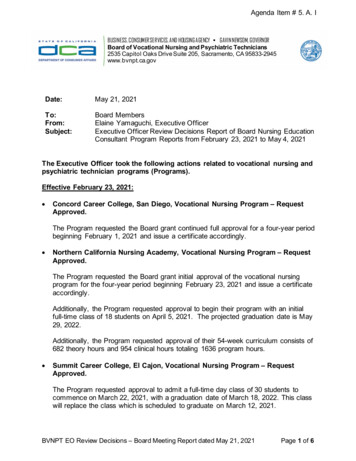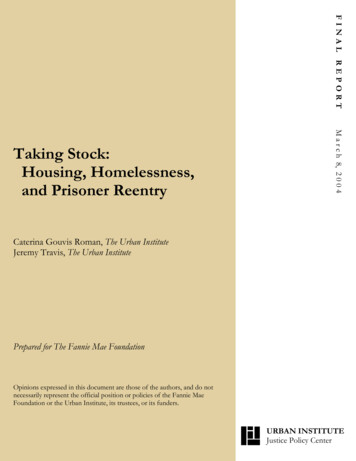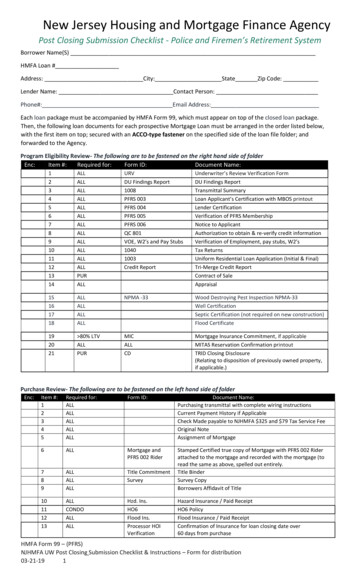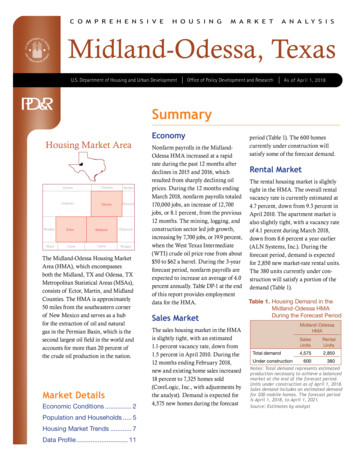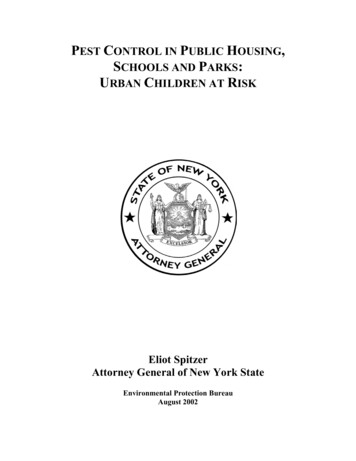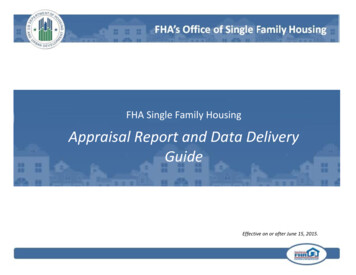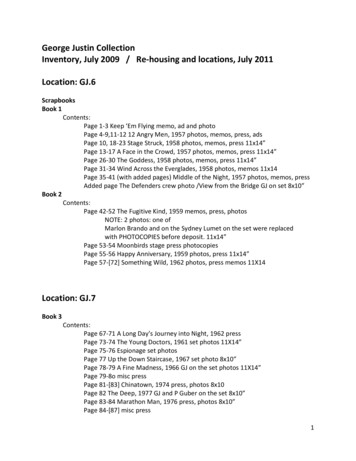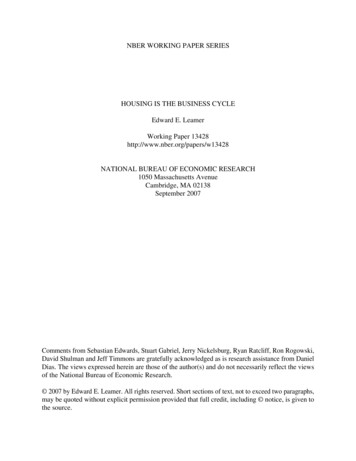
Transcription
NBER WORKING PAPER SERIESHOUSING IS THE BUSINESS CYCLEEdward E. LeamerWorking Paper 13428http://www.nber.org/papers/w13428NATIONAL BUREAU OF ECONOMIC RESEARCH1050 Massachusetts AvenueCambridge, MA 02138September 2007Comments from Sebastian Edwards, Stuart Gabriel, Jerry Nickelsburg, Ryan Ratcliff, Ron Rogowski,David Shulman and Jeff Timmons are gratefully acknowledged as is research assistance from DanielDias. The views expressed herein are those of the author(s) and do not necessarily reflect the viewsof the National Bureau of Economic Research. 2007 by Edward E. Leamer. All rights reserved. Short sections of text, not to exceed two paragraphs,may be quoted without explicit permission provided that full credit, including notice, is given tothe source.
Housing IS the Business CycleEdward E. LeamerNBER Working Paper No. 13428September 2007JEL No. E17,E3,E32,E52ABSTRACTOf the components of GDP, residential investment offers by far the best early warning sign of an oncomingrecession. Since World War II we have had eight recessions preceded by substantial problems in housingand consumer durables. Housing did not give an early warning of the Department of Defense Downturnafter the Korean Armistice in 1953 or the Internet Comeuppance in 2001, nor should it have. By virtueof its prominence in our recessions, it makes sense for housing to play a prominent role in the conductof monetary policy. A modified Taylor Rule would depend on a long-term measure of inflation havinglittle to do with the phase in the cycle, and, in place of Taylor's output gap, housing starts and the changein housing starts, which together form the best forward-looking indicator of the cycle of which I amaware. This would create pre-emptive anti-inflation policy in the middle of the expansions when housingis not so sensitive to interest rates, making it less likely that anti-inflation policies would be needednear the ends of expansions when housing is very interest rate sensitive, thus making our recessionsless frequent and/or less severe.Edward E. LeamerJohn E. Anderson Graduate School of ManagementUniversity of California, Los AngelesBox 951481Los Angeles, CA 90095-1481and NBERedward.leamer@anderson.ucla.edu
HOUSING, HOUSING FINANCE, AND MONETARY POLICYA Symposium Sponsored by theFederal Reserve Bank of Kansas CityJackson Hole, WyomingAugust 30 - September 1, 2007Housing Is the Business CycleEdward E. Leamer UCLARevised September 20, 2007IntroductionMy goal is to provide unforgettable images that leave a lasting impression regarding theimportance of housing to what we call the business cycle. Before we get to the displays,I need to issue a couple of caveats and comments.Housing and Academic MacroeconomicsThe bad news is that I am not a macro-economist. Wicksell and Hayek and Keynes andFriedman and Tobin and Lucas and Prescott speak foreign languages with which I havefamiliarity but not mastery.The good news is that I am not a macro-economist. That frees me from the heavyconceptual burdens that most macro economists seem to carry. It allows me to concludethat Keynesian thinking, monetarism, rational expectations and real business cycles allsuffer from the same problem – too much theory and not enough data. In particular, noneof these comes to grips with the role of housing in modern US recessions.Indeed, if you look up “real estate” in the index to Mankiw’s(2007) best sellingPrinciples of Macroeconomics, you will find real exchange rates, real GDP, real interestrates, real variables, and even reality, but no real estate. Under “housing” you will find areference to the CPI and to rent control, but no reference to the business cycle. I have not Professor of Management, Economics and Statistics, UCLA. Comments from Sebastian Edwards, StuartGabriel, Jerry Nickelsburg, Ryan Ratcliff, Ron Rogowski, David Shulman and Jeff Timmons are gratefullyacknowledged as is research assistance from Daniel Dias.1
been able to find any macroeconomic textbook that places real estate front and center,where it belongs.1But it’s not just a problem with our theory. The NBER macroeconomics data minershave largely missed housing too. The index to Victor Zarnowitz’ (1992) Business Cycle,Theory, History, Indicators, and Forecasting has no reference to real estate or to housing.(Actually, there are no “h”s in the index at all.) Likewise, the index to James H. Stockand Mark W. Watson’s edited volume, Business Cycles, Indicators and Forecasting, hasno references to residential investment or to housing. Housing is treated with the samelevel of interest that building permits has in the Index of Leading Indicators: one of manythings that might predict a recession, about as interesting as x7 in the list x1, x2, x3, .,x10.There is a substantial, mostly older literature on the modeling of residential investment.(e.g. Alberts(1962), Fair(1972), Ketchum(1954), de Leeuw and Gramlich(1969)) Thisliterature takes the overall business cycle as given and explores the effects of income andinterest rates on residential investment. By including interest rates as explanatoryvariables, this literature does explicitly explore the link from monetary policy to housing,but when Maisel(1967), for example, reports that residential investment is an importantchannel through which monetary policy affects the economy, that finding is treated likethe discovery that alcohol has it effects by depressing the central nervous system, whichis a mildly interesting fact that doesn’t at all affect how much we drink. Another roundof grog, please.Something’s wrong here. Housing is the most important sector in our economicrecessions and any attempt to control the business cycle needs to focus especially on1To get some insight into the current state of macroeconomics, I recommend a few pages from FrederickBrown’s biography Flaubert that describe the state of medicine in 18th Century France, contrasting thephysicians (theorists) with the surgeons (empiricists).Although France had produced the great surgeon Ambroise Paré in Rabelais’s time, it took mostof the eighteenth century and a battalion of philosophes challenging well-entrenched pieties toclear the ground for clinical medicine. Set against it were not only the church but a high culturewhose apologists felt impelled to frame the physical or sensual world in rationalist hypotheses.Behind its ogives on the rue de la Bûcherie, the Medical Faculty, where lectures were given inLatin and readily understood by youths, mostly wellborn, who had earned a master of arts degree,restricted its teaching to humane letters, to natural philosophy, and to medical theory derived fromclassical texts. Never dissecting a dead person or laying hands on a sick one, future physiciansbecame thoroughly conversant with Hippocrates and Galen, but remained largely ignorant ofhumanity in the flesh. Proud to be called antiquarum tenax, this establishment, which scoffed, forexample, at William Harvey’s discovery that blood circulates, regarded surgery as a subordinatediscipline, a manual or “mechanical” trade, fit for the dexterous and the inarticulate. .Threatened as they increasingly were, they sought shelter from modern times in the distinctionconferred upon humanists by their knowledge of the language that gave one access to medicalscripture. However skillful the artisan, without Latin he spoke without intellectual authority.(p.12) When medicine at last began to tilt decisively away from ancestor worship, visual analysis gainedground. Anatomical atlases gradually supplanted classical texts. (p.14)2
residential investment. But housing presents a special control problem because monetarypolicy affects mostly the timing of the building but not the total building. After a surgeof building there has to be a time-out, like we are experiencing today, before building canget back to normal, and before this channel through which monetary policy affects thereal economy is operative again. The Fed can stimulate now, or later, but not both.The differences in the dynamics of inflation and housing create a problem for the conductof monetary policy that is aimed at both inflation and housing-related employment.Inflation is very persistent, and needs to be fought every day. For housing it’s the cyclethat is persistent. Once the cycle starts, it keeps on going. Like a pebble thrown into asmooth pond of water. The best time to fight the housing cycle with tight monetarypolicy is when the wave is starting to rise, not when it is cresting. The worst time tostimulate the economy with loose monetary policy is when the wave is starting to rise.That is going to make the crest all the higher, and the crash all the more catastrophic.You know of which I speak, I suppose?To put the point as clearly as possible, what I am advocating is a modified Taylor Rulethat depends on a long-term measure of inflation having little to do with the phase in thecycle, and, in place of Taylor’s output gap, housing starts and the change in housingstarts, which together form the best forward-looking indicator of the cycle of which I amaware. This would create pre-emptive anti-inflation policy in the middle of theexpansions when housing is not so sensitive to interest rates, making it less likely thatanti-inflation policies would be needed near the ends of expansions when housing is veryinterest rate sensitive, thus making our recessions less frequent and/or less severe.WARNING: Causal conclusions from temporal orderingsThough I am not a macroeconomist, my econometric credentials do give me some specialknowledge of the problems of drawing causal inferences from nonexperimental data.Medieval empirics came to the conclusion that blood-letting helped because the health ofthe patients often improved after the blood was let, but we know now that temporalorderings do not reveal causality, even though Clive Granger(1969) has christened thepost hoc ergo propter hoc fallacy with the name “Granger Causality.”For valid causal conclusions, we need an experiment; we need a control group and atreated group. When all we have are non-experimental data, correlation is in the data butcausation is in the mind of the observer.With only temporal orderings and no experimental evidence, we do what empirics do: werely on stories. To each temporal ordering we attach a predictive narrative or a causalnarrative or both. We draw firm causal conclusions from the temporal orderings whenthe causal narrative is compelling and when there is no equally compelling predictivenarrative. This is literature and wisdom, not science.3
Take interest rates, for example. A pretty good predictive story is that the arrival of thestorm we call recessions is met by a reduction of interest rates. When the storminevitably dissipates, we cannot conclude that the interest rates caused the recoverymerely because of the temporal ordering: first the lowering of interest rates and then therecovery. We sometimes suggest that the umbrellas we carry stop the storms too, but Ithink we are only joking, aren’t we?We economists have a deep dislike of predictive narratives. Economics, unlike the othersocial sciences, is a self-consciously interventionist discipline. We think we aredesigning the best way for our governments to influence the outcomes. For that purpose,of course, we must have causal beliefs. Thus, so as not to confuse the initiates, ourintroductory economics textbooks rarely mention predictive stories, but instead weindoctrinate our students with the causal narrative of the IS-LM model or the equivalent.For some, the force of the causal story of the IS-LM model has been offset completely bythe power of the predictive narrative of the Lucas Critique. For most economists, theknowledge assumptions of the Lucas Critique make that story more than a little farfetched. Thus IS-LM thinking is very much alive.So there you have it: It’s faith-based decision making, which is much influenced by therhetorical skills of the advocates. I would be conveying accurately the scientific validityof the opinions expressed here if, in the printed version, about 50% of the pixels wereremoved so you could hardly read what I have written, and, in the spoken version, if Islurred my speech to the point that you could hardly understand what I have said.SummaryIn the next section, I remind you that for 35 years the US economy has been growing at asurprisingly constant rate of 3%. Within the range of policies tested over the last 35years, none has had a demonstrable effect on long-term growth. From that I concludethat all we need to worry about is the cycle, provided we don’t choose some risky newmaneuvers for this Titanic we call the economy.Section 3 reports the timing facts about the ten US recessions since World War II: Wehave experienced eight recessions preceded by substantial problems in housing andconsumer durables. We have experienced one Department of Defense downturn after theKorean Armistice in 1953 and one Internet Comeuppance in 2000/2001, driven by acollapse in business investment in equipment and software. Except for those two specialevents, it’s been a consumer cycle not a business cycle.A reason why housing is so important in recessions is the subject of Section 4. Ourmarket system relies on price flexibility to assure that labor and capital are productivelyemployed, but house prices are very inflexible downward, and when demand softens as ithas in 2005 and 2006, we get very little price adjustment but a huge volume drop. ForGDP and for employment, it’s the volume that matters.In Section 5 I discuss the financial cycle that supports the housing cycle, and look forevidence of a cycle in idiosyncratic house price risk and a cycle in the relative prices of4
expensive versus cheap homes, both of which may be symptoms of a mortgage marketthat reaches ever-deeper into the barrel of current-renters as the expansion continues,picking from that barrel homebuyers with lower incomes and weaker credit scores, whoare buying mostly the entry-level of homes. If these cycles do exist, they should attractthe attention of our monetary authorities because they cause damage to Americans whocan least afford it. The idiosyncratic risk in the Los Angeles market is surprisingly high(30% of value) but not apparently cyclical. But during the “bubble” that is now leaking,it was the smaller homes in the lower-priced zip-codes that experienced the greatest ratesof appreciation. That run-up in relative prices of the less-expensive homes could bepermanent if innovations in finance have permanently increased the fraction ofhomeowners, raising the relative demand for cheaper homes. But I doubt it. In 2007, allthe anecdotes suggest foreclosures are differentially favoring the lower-incomeneighborhoods, just as do the pink slips of labor market dismissals. We should careabout this.By virtue of its prominence in our recessions, it makes sense for housing to play aprominent role in the conduct of monetary policy. Section 6 deals with the policyconflicts between inflation targets and hypothetical housing targets. If housing were thetarget, our Fed has been missing the mark widely, most especially in the aftermath of the2001 recession when the Fed Funds rate was held so low for so long. Best to rememberthat the teaser rates for mortgages came from Washington, DC, not from Wall Street, andnot from your local mortgage originator.Of course, the Fed was pursuing an anti-deflation program in 2002-2004. But themessage from the housing market is that it is not general deflation or deflation of rentalrates that matters; it is the deflation of the asset prices of durables, particularly homes.Declining prices for assets like homes make the (own) real interest rate great even if thenominal interest rate is zero. For a highly leveraged investment like housing, it doesn’ttake much in the way of an asset price decline to kill off building, even if the rentalmarket is strong, and to completely eliminate any potential for a stimulative rate cut.Ironically, the Fed’s great concern about deflation has created the very deflation problemthey were trying to avoid.The inevitable effect of the low rates has been an acceleration of the home building clock,transferring building backward in time from 2006-2008 to 2003-2005. Our Fed thusimplicitly made the decision: more in 2003-2005 at the cost of less in 2006-2008. Thatstrikes me as a very risky choice. The historical record strongly suggests that in 2004 and2005 we poured the foundation for a recession in 2007 or 2008 led by the collapse inhousing we are currently experiencing. Only twice have we had this kind of housingcollapse without a recession, in 1951 and in 1967, and both times the Department ofDefense came to the rescue, because of the Korean War and the Vietnam War. We don’twant that kind of rescue this time, do we?But don’t worry. This time we don’t need the DOD to save us. This time troubles inhousing will stay in housing. It’s because manufacturing has done an “L” of a job. Anofficial recession cannot occur without job loss, but as can be seen in Figure 1, outside of5
manufacturing and construction there is little or no job loss. The sectors with volatileemployment are manufacturing and construction, illustrated in Figure 2. Look atmanufacturing. It’s V, V, V in every recession - a sharp drop in jobs and a sharprecovery. The 1990 recession was different. That was a U. But in the 2001 recession wegot an L! Though this is largely uncharted territory, it doesn’t look like manufacturing ispositioned to shed enough jobs to generate a recession. And without the job loss, expectthe housing adjustment to be shallower but more long-lasting.Finally, in the concluding section, in an already overly long paper, I offer some briefcomments on the links between consumer durables and homes, and briefly survey theliterature on housing and the business cycles in other countries.Figure 1Total Nonfarm Employment Excluding Manufacturing and ConstructionEmployment Excluding Manufacturing and Construction (1000s)Recessions Shaded, Data through 2007 040 45 50 55 60 65 70 75 80 85 90 95 00 05Figure 2Employment in Manufacturing and Construction (1000s)Recessions Shaded, Data through 2007 June10000Construction (Right Scale)30002000020001500VV V1600012000VVV1000UV V VManufacturing (Left Scale)LConstructionManufacturing5000500800040 45 50 55 60 65 70 75 80 85 90 95 00 056
The 3-3 Rule of US Real GDPAs far as US Real GDP is concerned, don’t worry about long-run growth.Make a list of events over the last 40 years that you imagine might have substantiallyaffected the level of US GDP. Does your list include the 1970s oil price shocks, theReagan tax cuts, the inflation of the 1970s, the evolution of real rates of interest, thepeace dividend, the economic liberalizations in the developing world, the personalcomputer, the Internet Rush, and the Bush W. tax cuts? Surely, you must imagine, mostof these have had an apparent impact on US GDP. Sorry, you are mistaken. Take alook at Figure 3, which illustrates US Real GDP with a logarithmic scale that turnsconstant rates of growth into straight lines. Since 1970, US Real GDP has snakedupward along a straight constant-growth line, seemingly ignoring completely all the“shocks” that have buffeted the system. Just in case you cannot see how straight theline has been, I have put a 3% corridor around the 3% trend line. That’s the 3-3 rule ofUS Real GDP. The US GDP rarely strays more than 3% from the 3% per year trend line.Figure 3The Narrow Corridor of US GDPThe Narrow Corridor of US Real GDPBillions of Dollars20000100008000600050004000300020003% Trend from 1970 to 2006with - 3% error bands100050 55 60 65 70 75 80 85 90 95 00 05I am not a believer in immutable constants of complex human social systems and the 3-3rule of GDP growth does not have the scientific validity of 9.8 meters per secondsquared, but the fact
familiarity but not mastery. The good news is that I am not a macro-economist. That frees me from the heavy conceptual burdens that most macro economists seem to carry. It allows me to conclude that Keynesian thinking, monetarism, rational expectations and real business cycles all suffer from the same problem – too much theory and not enough .
